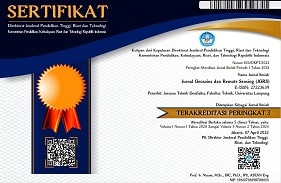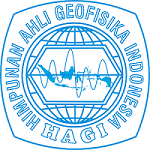Author Guidelines
Submission Guidelines for the Jurnal Geosains dan Remote Sensing (JGRS) may be found at the following link (Template_ID.docx or Template_EN.docx). Assume that the provided work does not adhere to this writing format. In that case, the editor has the option of rejecting the item prior to review. Make sure you have an account and are logged in to JGRS before submitting. If you do not already have an account, please visit the Instructions for Creating a New JGRS Account. Once you have an account and a manuscript that meets the JGRS template requirements, you may begin the submission process as detailed in the JGRS Manuscript Submission Instructions.
As part of the submission process, authors are required to check off their submission's compliance with all of the following items, and submissions may be returned to authors that do not adhere to these guidelines.
- The submission has not been previously published, nor is it before another journal for consideration or an explanation has been provided in Comments to the Editor.
- The submission file is in Microsoft Word file format (*.doc/*.docx).
- The text adheres to the stylistic and bibliographic requirements outlined in the Author Guidelines.
- The citations and bibliography have used Mendeley's reference manager.
Title
Guidelines for Writing and Submitting Articles to the Jurnal Geosains dan Remote Sensing (Arial 14pt Bold)
Title in Indonesian and English (for Indonesian-language manuscripts) or English (for English-language manuscripts), written in Arial letters, size 14, bold, 1 space, center margin, Capitalize Each Word, and no more than 20 words. The most recent topic or the outcome of research.
Authors
First Author1*, Second Author2 , Third Author1, 2 (10pt bold)
1Department of Geophysical Engineering, Faculty of Engineering, University of Lampung, Jl. Prof. Dr. Ir. Sumantri Brojonegoro, Bandar Lampung, Lampung, Indonesia 35141 (8pt italic)
2Unila Geoscience Research Team, Department of Geophysical Engineering, University of Lampung, Jl. Prof. Dr. Ir. Sumantri Brojonegoro, Bandar Lampung, Lampung, Indonesia 35141 (8pt italic)
The author's name (without an academic degree) and affiliation address are written in the middle of the first page, below the article title. Double spaces are used between the title and the author's name. In contrast, the author's affiliation address and name are separated by a single space. The responsible author, correspondence author, or corresponding author must be denoted by an asterisk (*).
Abstract
Abstracts should be written in Arial letters, 9 pts font, one space, and no more than 200 words. If the article is written in Indonesian, the abstract must be provided in both Indonesian and English (italic). Only if the article is written in English should the abstract be written in English. The abstract must be succinct and include the substance of the topic to be discussed, its aim, method of solution, scientific discoveries achieved, and conclusion. Abstracts for each language must be written in a single paragraph with a single column. Below the abstract text, keywords are placed in Arial letters, and size 9 pts. Keywords are highlighted and arranged alphabetically.
Keywords: article; geosains; guideline; remote sensing; unila
Manuscript Structure
The scientific article's manuscript must include the following components (in order): (a) Article Title, (b) Author Name (without title), (c) Author Affiliation Address, (d) Abstract and Keywords, (e) Introduction, (f) Research Materials and Methods, (g) Results and Discussion, (h) Conclusions, I Acknowledgements, and (j) Bibliography. Subtitles throughout the article's contents (Introduction, Research Materials and Methods, Results and Discussion, and Conclusions) must be numbered consecutively in Arabic numeral format, beginning with one. Subtitles are written in capital letters in bold and aligned to the left without underlining. Sub-titles are written in bold using the Title Case format, placed to the left, and numbered on the second level.
Research methods
Describes the instruments and materials utilized and the typical procedures for data gathering and display. Various formulae or scientific formulas, as are explanations of qualitative and/or quantitative data, data gathering techniques, and data analysis procedures, are also explained. Describe the various sorts of tools and basic materials in detail. Explain the process of collecting, processing, and evaluating data and the process of concluding.
Manuscript
Manuscripts must be written in Indonesian or English and must be at least 7 pages long and no more than 15 pages long, including figures and tables. Manuscripts must be written in ready-to-print (Camera Ready) MS Word format (doc/docx) in accordance with this article template. Manuscripts must be written in Arial font, 10pt font size (except for article titles, author names, and abstract titles), single spaced, and two-column format (except for the article title, author name and abstract and large images). The columns are separated by 5 mm. Italics are used for foreign words or concepts. It is preferable to avoid utilizing foreign terminology in Indonesian publications. New paragraphs begin 5 mm from the left border, with no space between them.
Tables and Figures
After the table or figure is referred to is placed in the text group. Each picture must have the image title below it and be numbered in Arabic, followed by the image title. Each table must be labeled with an Arabic numeral and numbered above the table, followed by the table title. Images must be ensured to print clearly (font size, resolution and line size must be sure to print clearly). Figures, tables, and diagrams/schematics should be put between groups of text in columns or in the centre of the page if they are too large. Vertical lines are not permitted in tables, while horizontal lines are permitted only in column headers and the table's last row.
References
All references cited in the article's content must be referenced in the Bibliography section. The bibliography must include reference libraries derived from original sources (scientific journals and at least 80% of the bibliography) published during the previous 10 (ten) years. At least 12 (twelve) references are included in each article. Writing a reference system in the article's text and a bibliography in APA format, and preferably utilizing a reference management application tool, such as Mendeley.
References in scientific journals:
Yudhicara, Muslim, D., & Sudradjat, A. (2017). Geomorphic analysis in determining tectonic activity affected by Sumatra Fault in Liwa region and its surrounding area, Lampung, Indonesia. Indonesian Journal on Geoscience, 4(3), 193–208. https://doi.org/10.17014/ijog.4.3.193-208.
Zaenudin, A., Darmawan, I. G. B., Armijon, Minardi, S., & Haerudin, N. (2018). Land subsidence analysis in Bandar Lampung City based on InSAR. Journal of Physics: Conference Series. https://doi.org/10.1088/1742-6596/1080/1/012043.
Book References:
Sarkowi, M. (2014). Gravity Exploration. Yogyakarta, Indonesia: Graha Ilmu.
Telford, W. M., Geldart, L. P., & Sheriff, R. E. (1990). Applied geophysics. 2nd edition. New York, USA: Cambridge University Press.
Proceedings:
Darmawan, I. G. B., Setijadji, L. D., & Wintolo, D. (2015). Geology and Geothermal System in Rajabasa Volcano South Lampung Regenc , Indonesia (Approach to Field Observations , Water Geochemistry and Magnetic Method). World Geothermal Congress, 12, 1-10.
Putra, D. B. E., Samsudin, A. R., & Choanji, T. (2016). Geophysical Modelling Using Gravity Data Of Meteorite Impact Crater At Bukit Bunuh, Lenggong, Perak, Malaysia. Proceeding of The 7th Indonesia Japan Joint Scientific Symposium, 1, 515–524.
Thesis:
Kippenberg, T. J. A. (2004). Nonlinear Optics in Ultra-high-Q Whispering-Gallery Optical Microcavities. PhD Thesis. Caltech Institute.
HandBook:
Kemp, A. C., & Telford, R. J. (2015). Transfer functions. In Handbook of Sea-Level Research (hal. 470–499). Wiley Blackwell. https://doi.org/10.1002/9781118452547.ch31.
Internet Website:
Bustan, M. T. S. (2019). Alat Pendeteksi Gempa BMKG Palu Dicuri. Diakses pada 18 Agustus, 2019, dari https://mediaindonesia.com/read/detail/249393-alat-pendeteksi-gempa-bmkg-palu-dicuri







.png)
.png)




